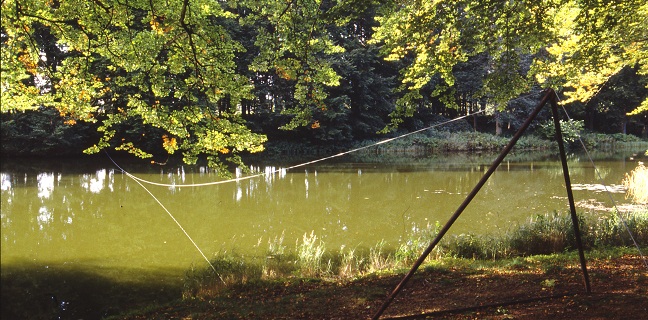
Bernard Kirschenbaum
(1924–2016, föddes i/was born in New York)
Cable Arc, 1987
Bly, svetsat stål, vajer/Lead, welded steel, wire cable
Varierande mått/Dimensions variable
For English please scroll down
Bernard Kirschenbaum skapade Cable Arc till den första konstutställningen på Wanås 1987. I utställningen medverkade 25 konstnärer som ställde ut i parken, Kirschenbaums verk är det enda från utställningen som blev permanent.
Cable Arc speglar Kirschenbaums långa intresse för bågen som form. I verket på Wanås skapas formen av en vajer som späns mellan två ståltrianglar fästa i marken på varsin sida om dammen, så att Cable Arc förenar dess östra och västra strand. Vajern drar ihop sig vid kyla och expanderar när det är varmt, men svävar alltid ovanför vattenytan. Skulpturen skapar en rörelse i och med att vajern hänger fritt i luften, men också i förhållande till det minskande och ökande avståndet till vattenytan. Kirschenbaum var en av få konstnärer på Wanås 1987 som formade sitt konstverk efter förutsättningar på platsen, det som senare blivit karaktäristiskt för många av konstverken på Wanås.
Kirschenbaum utbildade sig till arkitekt på 1950-talet och övergick successivt till att arbeta med konst. Han började tidigt använda sig av datorer i sitt konstnärskap och intresserade sig för geometrins och teknikens möjligheter i kontrast till ett mjukt formspråk. Med matematisk precision skapade han verk som ofta laborerade med spänningen mellan materialitet och tomrum, mellan lätt och tungt. Kirschenbaum var under 1980- och 1990-talen inflytelserik på den svenska konstscenen, med stora utställningar på svenska konstinstitutioner och som professor i skulptur på Kungliga Konsthögskolan i Stockholm.
>>>
Bernard Kirschenbaum created Cable Arc for the first art exhibition at Wanås in 1987. 25 artists participated in the exhibition, and while they all exhibited in the park, Kirschenbaum’s artwork is the only one from the exhibition that is now a permanent part of the collection.
Cable Arc reflects Kirschenbaum’s enduring interest in the arc as a form. In the artwork at Wanås, the form is created by a cable stretched between two steel triangles, attached to the ground on either side of the pond, so that Cable Arc unites the eastern and western banks. The cable constricts in cold weather and expands when it is warm, but it always sways over the water’s surface. The sculpture creates movement in that the cable hangs freely in the air, but also because of the increasing and decreasing distance to the surface. Kirschenbaum was one of few artists at Wanås in 1987 who formed his artwork to the specific conditions of the site, which later became characteristic for many of the artworks at Wanås.
Kirschenbaum trained as an architect in the 1950s, but soon ventured into art. He began using computers in his artwork early on and was interested in the possibilities of geometries and technology in contrast to a softer idiom. With mathematical precision, he created works that often experimented with the tension between materiality and emptiness, between lightness and heaviness. In the 1980s and 1990s, Kirschenbaum was influential in the Swedish art scene, with large exhibitions at Swedish art institutions, and as a professor of sculpture at the Royal Institute of Art in Stockholm.